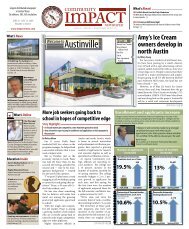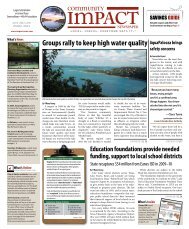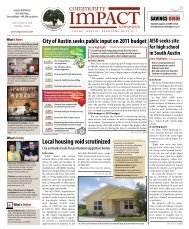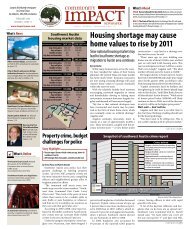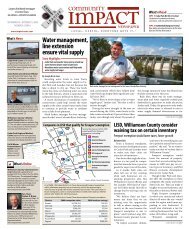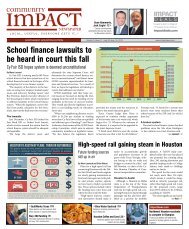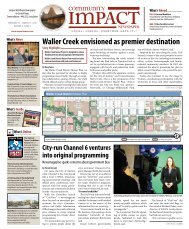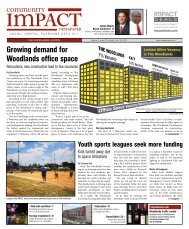Higher education programs receive funding, grants - Community ...
Higher education programs receive funding, grants - Community ...
Higher education programs receive funding, grants - Community ...
Create successful ePaper yourself
Turn your PDF publications into a flip-book with our unique Google optimized e-Paper software.
At the Capitol Major higher <strong>education</strong> reforms<br />
New laws address flagship status and admissions<br />
By Patrick Brendel<br />
Texas lawmakers passed legislation<br />
creating incentives for public colleges to<br />
strive toward achieving Tier One research<br />
university status. They tweaked the state’s<br />
Top 10 Percent rule for college admissions<br />
for the University of Texas at Austin<br />
but balked at completely reforming the<br />
system. Legislation to re-regulate college<br />
tuition increases failed at the end of the<br />
Regular Session.<br />
Flagship universities<br />
The state of Texas has two public Tier<br />
One research institutions: UT-Austin and<br />
Texas A&M in College Station. (The other<br />
Texas Tier One school is the private Rice<br />
University in Houston.) In contrast, California<br />
has nine “flagship” schools, while<br />
New York has five.<br />
Colleges throughout the state are vying<br />
for the elite Tier One status and the accompanying<br />
prestige and funds. Contenders<br />
include the University of Houston,<br />
Texas Tech University in Lubbock,<br />
University of North Texas in Denton,<br />
UT-Arlington, UT-Dallas, UT-El Paso<br />
and UT-San Antonio.<br />
To avoid inciting regional animosity,<br />
lawmakers shied away from designating<br />
particular schools as Tier One, instead<br />
creating incentives for emerging research<br />
universities and a process to achieve Tier<br />
One designation.<br />
The legislation establishes three incentive<br />
funds that would go to colleges<br />
according to research performed, number<br />
of degrees awarded and amount of private<br />
gifts <strong>receive</strong>d. The bill is meant to encourage<br />
all types of public four-year colleges<br />
to improve, not just to reward one or two<br />
schools with Tier One status.<br />
Schools striving for Tier One status<br />
would have to submit detailed, long-range<br />
strategic plans to the Texas <strong>Higher</strong> Education<br />
Coordinating Board, which is in<br />
charge of Tier One designations.<br />
The Tier One legislation also included<br />
$150 million in bonds to rebuild the<br />
University of Texas Medical Branch at<br />
Galveston. The campus was severely damaged<br />
by Hurricane Ike last fall. Another<br />
related bill allows Texas A&M to start<br />
working toward the creation of a fouryear<br />
college in downtown San Antonio.<br />
Top 10 Percent<br />
Since 1997, Texas high school students<br />
graduating in the top 10 percent of their<br />
class are guaranteed admission to the<br />
public college campus of their choice. The<br />
law has been credited with removing disparities<br />
in admissions between students<br />
from rural and urban areas, but has not<br />
led to racial equality in freshmen classes.<br />
The University of Texas at Austin has<br />
long pushed legislators to change the<br />
Top 10 Percent rule, citing shrinking<br />
flexibility in admissions decisions as it<br />
voluntarily attempted to restrain the total<br />
number of students enrolled each year.<br />
Last fall, more than 75 percent of enrolled<br />
freshmen were admitted under the Top 10<br />
Percent rule. Almost half of Texas A&M’s<br />
fall 2008 freshman class were Top 10<br />
Percent students.<br />
Legislators gave serious consideration<br />
to a bill that would have significantly<br />
reformed the Top 10 Percent Rule. Under<br />
that proposal, Top 10 Percent students<br />
would not necessarily be guaranteed the<br />
campus of their choice. The bill capped<br />
the number of Top 10 Percent students<br />
a campus has to accept at 50 percent of<br />
freshman admissions. (Another version<br />
of that bill set the cap at 60 percent.)<br />
Students would be admitted to the campus<br />
according to their percentile rank.<br />
Students not admitted would be assigned<br />
to a different campus within the same<br />
university system.<br />
On the House floor, an impromptu<br />
coalition of rural and minority legislators<br />
swamped the proposal because they<br />
believed that the Top 10 Percent Rule<br />
provided a more level playing field for<br />
their constituents.<br />
They approved an amendment to the<br />
bill that makes it applicable only to UT-<br />
Austin. The legislation allows UT-Austin<br />
to cap the amount of Top 10 Percent students<br />
at 75 percent of the freshman class.<br />
Tuition re-regulation<br />
Due to shortfalls in state <strong>funding</strong> for<br />
higher <strong>education</strong>, in 2003 the Legislature<br />
began allowing Texas colleges to set their<br />
own tuition rates. Since then, tuition and<br />
fees have risen by more than 85 percent.<br />
In an attempt to rein in skyrocketing<br />
college costs, lawmakers tried to pass<br />
legislation that prohibits Texas’ major<br />
schools — including UT and Texas A&M<br />
— from increasing their tuition and fees<br />
by more than 5 percent each year.<br />
Schools would be allowed to create <strong>programs</strong><br />
so that incoming freshmen could<br />
“lock in” their first-year tuition rate for<br />
four years.<br />
Some colleges would not be allowed<br />
to raise tuition and fees at all, unless a<br />
legislative study determined that state<br />
<strong>funding</strong> is insufficient. The legislation also<br />
encouraged state lawmakers to provide<br />
adequate <strong>funding</strong> to public higher <strong>education</strong><br />
institutions.<br />
In the end, objections from the university<br />
systems won out, and no changes<br />
were made to tuition deregulation.<br />
impactnews.com June 2009 | 13<br />
What are you doing this fall?<br />
Sign up for fall semester classes.<br />
Current students can register now! New students register June 15.<br />
austincc.edu (512) 223.4ACC<br />
Fall 09 Registration - <strong>Community</strong> Impact 4.9 x 2.94.indd 1 5/18/09 9:44:36 AM<br />
Exit 264, 2534 N. Austin Ave. • Georgetown, Texas 78626<br />
www.ctpowersports.com<br />
SURVIVE<br />
CANCER<br />
Texas Oncology–Round Rock<br />
2410 Round Rock Ave., Ste. 150<br />
Round Rock, Texas 78681<br />
512-341-8724<br />
Texas Oncology–Cedar Park<br />
1401 Medical Parkway B, Ste. 412<br />
Cedar Park, Texas 78613<br />
512-260-6050<br />
Texas Oncology–Seton Williamson<br />
301 Seton Parkway, Ste. 104<br />
Round Rock, Texas 78665<br />
512-687-2300<br />
www.TexasOncology.com




